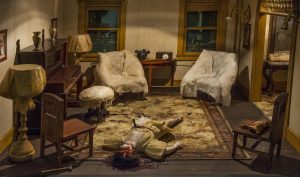It’s funny how the themes of one course often dovetail with and echo those of another, especially when that’s not my intention. As the semester drew to a close, the geometry of space -- and with it, the cultural significance of boxes -- came unexpectedly to the fore in both my classes.

To cap off their semester-long inquiry into the life of things, my undergraduate students visited a marvelous exhibition at the Renwick Gallery called “Murder Is Her Hobby.” Featuring nineteen carefully documented renditions of a crime scene down to the smallest detail -- a kitchen apron, a wall calendar, a batch of newspapers crumbled on the floor, a cracked window, blood splatter -- they bring to mind miniaturized period rooms, or better yet, dollhouses. Each case study is housed in a small box-like structure and every artifact within it is tiny.
The handiwork of Frances Glessner Lee, the first female police captain in the United States, these were no playthings. Exercises in forensic science rather than aesthetics, they were designed to train law enforcement personnel in the spotting of clues and the solving of crimes. Mental acuity, not fun, was the point.
“Murder Is Her Hobby” challenged the visual imagination, where the Berlin Jewish Museum’s 2013 exhibition, “The Whole Truth ... Everything You Always Wanted to Know about Jews,” rattled the moral imagination of my graduate students, who, four years later, were taking its pulse as well as that of other Jewishly-themed exhibitions since the late 19th century. The star attraction of that exhibition was a single plexiglass box that contained only one thing – a Jewish person, or, more precisely, a changing roster of Jewish people.
Designed to encourage visitors to pose questions about Judaism and Jewish history they might not otherwise have had an opportunity, or were reluctant, to ask, the well-intentioned exhibition -- soon known as the “Jew in the Box” -- foundered on the shoals of controversy.
It was one thing, after all, to put Jewish history and culture on display; quite another, especially in Berlin, of all places, to put real-life Jews on display as if they were objects, no matter how willing their participation.
Some of the students argued in favor of the “Jew in the Box,” claiming that it provided an opportunity for dialogue and conversation, demystification and normalization. Others thought it inappropriate, tone-deaf to history, rendering the Jew a curiosity -- or worse.
As you can well imagine, our discussion got a little heated. But then, that is as it should be. No matter their size or degree of ornamentation, boxes ought not to imprison us.

